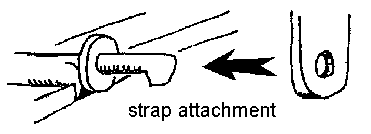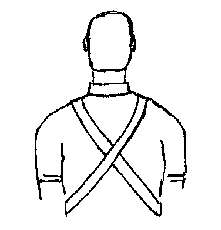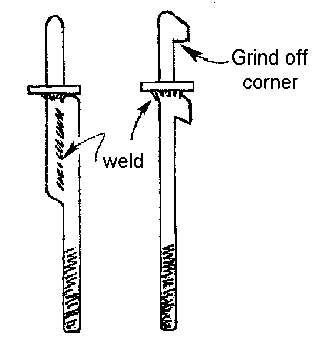Appendix 5 - My Double Banjo Strap
Click here for a printer-friendly version (pdf).
 I came up with this in conjunction with my lessons in the Alexander Technique, with the aim to use my body more efficiently from a mechanical or engineering standpoint. The underlying idea is to have the same weight on each side of my spine, so that there is no need to twist my body to maintain balance while carrying the banjo on my shoulders. For you to do this, you need to find the center of gravity (c.g.) of your instrument.
I came up with this in conjunction with my lessons in the Alexander Technique, with the aim to use my body more efficiently from a mechanical or engineering standpoint. The underlying idea is to have the same weight on each side of my spine, so that there is no need to twist my body to maintain balance while carrying the banjo on my shoulders. For you to do this, you need to find the center of gravity (c.g.) of your instrument.
The c.g. is found hanging the banjo from any hook on the side of the pot, and noting where a line from that hook straight down to the ground crosses the third string. Normally this will be about 2 or 3 inches from the base of the neck. It will not be in the center of the head. This is the spot that needs to be in line with your spine.
 This need to have the same weight on each shoulder led to a double strap arrangement that crosses in the back, but is not connected together there. There is a hook with a 1/2" extension, actually another hook and a flat washer welded to the side of it. This extended hook replaces the 4th, 5th or 6th hook above the neck. This extra strap is removable with the other end at the 3rd hook under the neck attached in the usual way. The other strap from the 1st hook under the neck to the hook just above the tailpiece is the regular placement for a single one worn over the left shoulder. This makes the system fail safe; if the second strap became unhooked, the banjo cannot fall to the ground. The choice of where to put the modified hook is determined by the present shape of your torso and where the c.g. is on your banjo.
This need to have the same weight on each shoulder led to a double strap arrangement that crosses in the back, but is not connected together there. There is a hook with a 1/2" extension, actually another hook and a flat washer welded to the side of it. This extended hook replaces the 4th, 5th or 6th hook above the neck. This extra strap is removable with the other end at the 3rd hook under the neck attached in the usual way. The other strap from the 1st hook under the neck to the hook just above the tailpiece is the regular placement for a single one worn over the left shoulder. This makes the system fail safe; if the second strap became unhooked, the banjo cannot fall to the ground. The choice of where to put the modified hook is determined by the present shape of your torso and where the c.g. is on your banjo.
 This modified hook is for a removable strap that just slips on over it with the lower end at the 3rd hook under the neck. The strap from the 1st hook under the neck to the hook just above the tailpiece is the regular placement for a single one worn over the left shoulder in the usual way. This makes the system fail safe, if the second strap should become unhooked, the banjo cannot fall to the ground.
This modified hook is for a removable strap that just slips on over it with the lower end at the 3rd hook under the neck. The strap from the 1st hook under the neck to the hook just above the tailpiece is the regular placement for a single one worn over the left shoulder in the usual way. This makes the system fail safe, if the second strap should become unhooked, the banjo cannot fall to the ground.
 The straps themselves are 1-½" belt tooling leather, chosen because this width fits nicely in the case alongside the resonator. If you have some adjustable straps in hand, it will make finding the lengths easier if you want to use plain straps like this. I like using plain strips of leather because there are no hard parts loose in the case to potentially scratch the banjo, and the leather is stiff and easily fastens over the modified hook.
The straps themselves are 1-½" belt tooling leather, chosen because this width fits nicely in the case alongside the resonator. If you have some adjustable straps in hand, it will make finding the lengths easier if you want to use plain straps like this. I like using plain strips of leather because there are no hard parts loose in the case to potentially scratch the banjo, and the leather is stiff and easily fastens over the modified hook.
I have used this system for over 10 years without any modifications except to change the strap adjustments as my body gradually grew straight again. I had developed a permanent spinal offset and tilted shoulders. Most of the change happened within months while taking my weekly lessons in the Alexander Technique. I have played for hours on end while wearing these straps, and while I still do get tired, I have no back pain per se. This system works.
You will have to build this strap system yourself. I am not offering the straps or hook for sale at this time. Built singly it is quite time intensive to fabricate, especially the hook. Each one is a hand made prototype. It involves the welding, hand filing, finishing, sending the hook off to be re-plated at FQMS, and all my time to make this happen, etc. The present retail cost considering the actual time involved would be US$200 - at a minimum. The material cost is less than US$20 including the leather. This is why I offer the design here, so that you can build your own.
There is a more complete article about this and the philosophy of the design in in the August 1992 Banjo Newsletter, and the back copy is available from the publisher. There is one typo in the article, in the qualities it needs to read fail safe instead of feel safe. It actually does feel super safe too....
~Gestalt Banjo Vol. 1~
Last Updated 15 Jul 2006 by PJH
Edited 09 Apr 2007 by WF